Greetings!
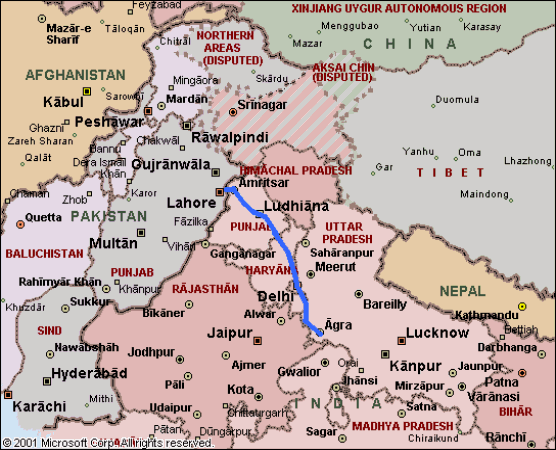
This week’s offering takes us to what is arguably the most famous building on earth: the Taj Mahal. Sights so mega-famous like this present us with a quandary: they rarely live up to expectations and so we come away disappointed, but then it is silly to go to somewhere like Egypt and not check out the Pyramids.
The Taj Mahal did not disappoint but at the same time, it was hardly my India highlight either. That said, it is an incredibly beautiful building and so I would recommend going to it – and the Pyramids and Great Wall of China and Angkor Watt and Big Ben – since, well, it’s a unique witness to mankind’s architectural achievements.
Only make sure that you visit some other sights as well.
Keep travelling!
Uncle Travelling Matt

Agra
There is only one reason why the vast majority of tourists come to Agra and that is India's – and one of the world's – biggest drawcards: the Taj Mahal. Like Angkor Wat, the Eiffel Tower, the Great Wall of China, the Pyramids and Macchu Picchu, the Taj is simply too good to miss and so miss it I would not. However, such Wonders of the World deserve both time and good conditions in which to fully appreciate them; a spare hour at the fag end of a rainy day did not constitute either and so I opted to leave the Taj for the morrow and instead to check out one of Agra's lesser sights: Emperor Akbar's Tomb.
One of my main preparations prior to this trip had been to head out to Handsworth in Birmingham, an area where many Sikhs live, and purchase a few choice Bollywood DVDs to put me in the mood. And one of those films that I bought was Ashutash Gavariker's 2008 historical epic 'Jodhaa Akbar' which recounts the story of the Muslim Mughal Emperor Akbar's marriage to the Hindu Rajput Princess Jodhaa. Now, I admit that I largely bought it because it stars the delectable Aishwarya Rai as Jodhaa for she is a lady who can make even a Nicholas Cage film watchable, but after sitting through only half an hour or so I realised that it had far more going for it than just her, for in addition to sumptuous costumes, stunning locations, the captivating Aishwarya and some exquisitely beautiful music, it also had a cracking storyline in which Emperor Akbar stood centre stage.
Akbar was the third Mughal Emperor, ruling from 1556 until his death in 1605. For the first six years of his reign he ruled through a regent, Bairam Khan, due to his young age. During that period the Mughal gains in India under Akbar's father, Humayon, were consolidated, but after his full ascension to the throne, Akbar extended his territories considerably, trebling the size of the empire that he reigned over. It is not however, for his conquests that Akbar is best remembered, but instead more for the manner of his rule. Instead of imposing an Islamic state on all his peoples, he was conciliatory towards local rulers and customs and inquisitive and tolerant of other faiths. At his court at Fatepur Sikhri he built a chamber named the Ibadat Khana (House of Worship) where he invited those of other faiths to explain their beliefs and debate with one another. He entertained Portuguese Jesuit Priests, (he also had the New Testament translated), Jain masters, a variety of Hindu holy men, (he even allowed Brahmin priests to tie sacred threads around his wrists), as well as numerous Muslim clerics from all shades of Islam. It is also recorded that he met the Third Guru, Guru Amar Das, at his home in Goindwal and was so impressed by the nascent Sikh faith that he presented the land upon which the Golden Temple would later be built to Amar Das' daughter Bhani as a wedding gift when she married Ram Das who would later become the Fourth Guru.
Despite all of this tough, Akbar never thought about converting and remained strong in his own Islamic beliefs, being a steadfast devotee of the Chisti Sufis such as Hazrat Nizamuddin whose dargah I'd visited that very morning. This all made sense to me as a man inquisitive and tolerant of all faiths but in love with his own, (well, the less bigoted versions of it), and so I felt it only right to make his mausoleum the next port-of-all on my Indian odyssey.
That mausoleum was a drive of several kilometres out of town. My driver was chatty and pointed out the sights en route, the most notable being the magnificent St. John's College, one of the earliest colonial educational institutions in India, established in the 1850s and its building a fine Anglo-Indian Mughal-cum-Gothic fantasy.
Akbar's Tomb was remarkable. Anywhere else and it would be the star attraction in the district if not the entire country but in a city that houses the Taj Mahal then it is never going to be that well-known. I appreciated it fully though, since it was the first such mausoleum that I had visited, (after visiting several more they all began to look alike), and because of the man who was buried there. Sat in the vast, dark and dank chamber I felt a sense of awe similar to that which one feels at a saint's tomb, whilst outside I admired the structure in dark brown stone and marvelled at the echoes that the building produced, (demonstrated to me by a “guide” for a tip), and was thankful for the shelter that it provided as the rain increased. As the drops descended in torrents outside, I fell into conversation with some schoolchildren on a class trip who all wanted their photos taken with this weird Westerner whilst I hoped that the downpour would ease as we chatted. But it did not and so in the end I made a run for it and ordered my taxi to take me to a good restaurant which he did although the paneer curry that I ordered was both a tad too cheesy and expensive. And then, by 17:00, I was in bed, shattered by a lack of sleep the night before, a train journey from hell and the tiring after effects of my food poisoning. Besides, I needed to be fresh for the next morning. After all, it's not everyday that you are scheduled to visit the most famous building on earth...
What can I write about the Taj Mahal that has not been written already? “A teardrop on the cheek of eternity”; “The embodiment of all things pure” and a thousand other tributes to the building that made “the sun and the moon shed tears from their eyes”; the ultimate monument to love. No, I cannot do better than that and so I won't even try.
And it was beautiful. World famous sites, familiar from the pages of childhood atlases, often disappoint first hand but the Taj does not. Although similar in layout to Akbar's Tomb, it is in a total different league and that is not just one of scale. The Taj is architecturally perfect, (and up-kept to a higher standard than any other building that I visited in India), and its construction out of white marble makes it doubly unique in an area where everything else is built out of red sandstone.
The Taj Mahal was built between 1631 and 1653 at the orders of Shah Jahan, the fifth Mughal Emperor as a monument to his beloved third wife, Mumtaz, who died in childbirth. Over twenty thousand labourers worked on it with specialists being brought in from as far away as Europe. It remains to this day the pinnacle of man's architectural brilliance.
Yet despite all that, there was something lacking. It was beautiful, it was incredible, and yet it was also somehow empty. Compared to the Golden Temple or even the Hazrat Nizamuddin Dargah, it paled into insignificance. To some people the whole 'Monument to Love' thing resonates, yet for me it does not, (that must be what divorce does to you, eh?). The emperor who is buried there beside his beloved wife, (his tomb is the only non-symmetrical element in the entire ensemble), was no more than a tyrant who secured his throne by executing all male relatives who stood in his way and who is most famous for constructing a vast monument which strained the resources of his empire and served no useful purpose. Akbar's Tomb may have been humbler, but the man whose remains that it housed was far, far greater.
After seeing the main sight, it was now time to explore the rest of what Agra has to offer and so it was off to Attraction No. 2, world-class in its own right, the Agra Fort with a stop off in Shah Jahan Park en route.
Agra Fort, one of the finest Mughal forts in India, was begun by Emperor Akbar in 1565 but was added to as the years progressed with Shah Jahan transforming it from a military structure into a palace. I spent a happy few hours wandering around inside its red sandstone confines, enjoying a detailed commentary through a walkman with headphones that I had rented out. Normally I don't go for such things, I certainly hadn't bothered at the Taj, but it was worth it this time for it helped me to piece together not only what I saw in the fort but also what I had seen at the Taj, Akbar's Tomb and during the film 'Jodhaa Akbar'. Agra Fort is a gorgeous and fascinating complex containing such oddities as a multi-storey well and a gigantic cooking pot but perversely, although I got more from it than I had the Taj, the highlight of it all was in fact looking out from the windows of the harem to the Taj Mahal shimmering in the distance on the silvery banks of the Yamuna.
Sightseeing done, (or at least as much as I could cope with for the day), I then moved onto more mundane matters, namely the purchasing of souvenirs and gifts for friends and, after my Delhi to Agra unreserved ticket experience from Hell, train tickets. My tuk-tuk driver took me to some touristy shops where I bought the mandatory mini Taj models and Indian jewellery before then dropping me at a travel agents where I spent a good hour or so organising all my future train tickets to Jaipur, then Ajmer, then back to Delhi. Yes, it was more expensive than buying them at the station, but it felt good to have them all guaranteed and safe in my hand as I walked out. Now I could relax without any concerns as to my itinerary.
Perhaps because I was feeling so thankful, (but more because it was a Sunday), I asked my driver to find me a church and the one that he located happened to have a Mass just about to start so I headed in. St. Mary's RC was an old colonial building that looked extremely European but was attended only by Indians. Still, the service was in my native tongue with some smatterings of Hindi and the theme of the sermon, temptation. Not particularly piously, I spent most of my time pulling monster faces at a rather cheeky-looking little lad on the pew in front of me, but I did pick up some of the priest's message, namely that some people were trying to cheat the Church – and thus God – by putting 10 rupee notes in the collection plate that were actually two halves of different notes sellotaped together and thus totally worthless, and that it was time to cough up for the annual cemetery tax, a whopping 75 rupees (£1) per person.
That evening, after recovering from the day's exertions, I took a stroll out to the Kinari Bazaar where I bought some toys for my son, checked the internet, uploaded some videos onto YouTube and dined on some excellent South Indian dosa at a street eatery called 'MAMA VEG WANT2EAT'. As I was doing so I realised that the last vestiges of my illness had now completely disappeared, as too had my culture shock. Delhi with its bazaars, chaos and poverty, had overwhelmed me, so too had Amritsar beyond the confines of the Golden Temple, yet here in Agra where it was all much the same, I was no longer bothered. I was beginning to get used to India.
In fact more than that, I was beginning to enjoy it.
Technorati Tags: uncle travelling matt,matt pointon,incredible india,india,agra,taj mahal,travel,blog,jodhaa,akbar,akbar's tomb,agra fort,mughal gurdwara,mumtaz,shah jehan,catholic church,tourism,tourists,vegetarian food,marble,yamuna


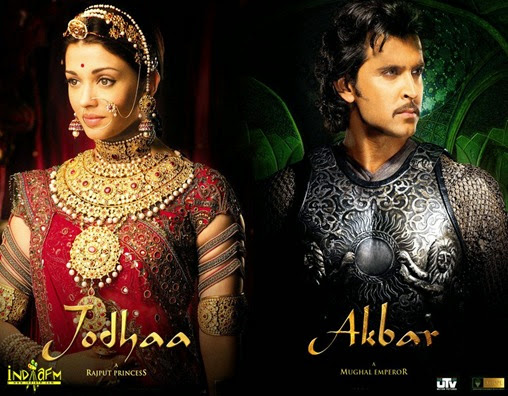
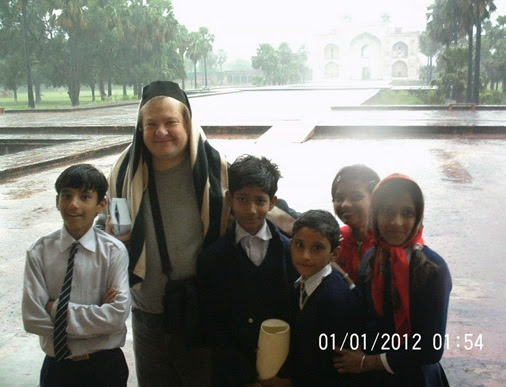
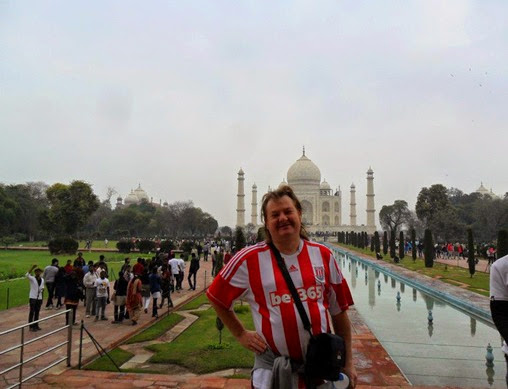
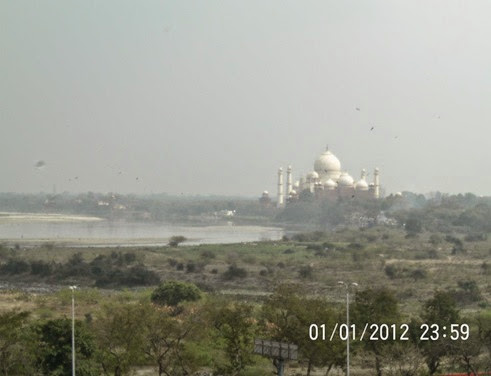
No comments:
Post a Comment